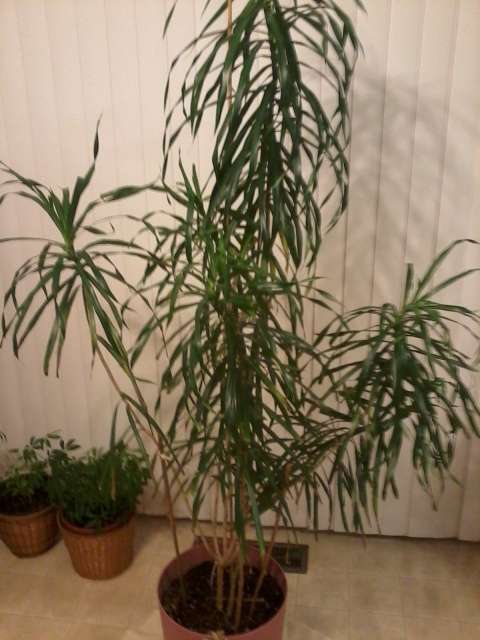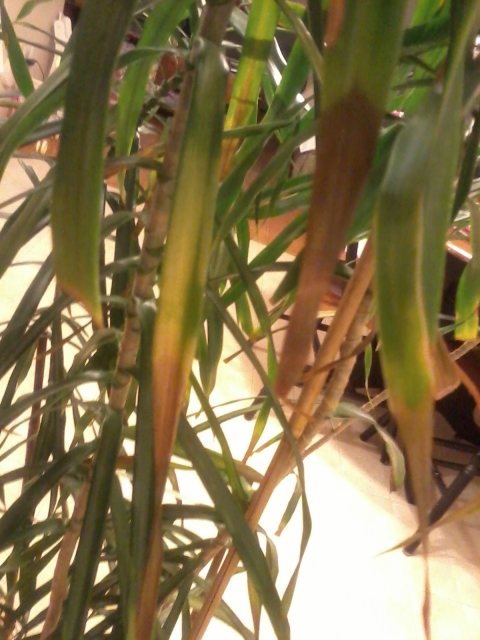Question whole plant
whole plant
 yellow/brown tips
yellow/brown tips
QUESTION: Please help!! I think ive made some terrible mistakes. I've had my Anita for about 5+years now and everything was fine until about two months ago when I noticed it was very root bound. The plant wasnt showing any signs of stress yet, but i still went ahead and repotted. Its was in 9.5" ceremic pot and i moved it up to 12"plastic pot (could not find11.5). The plant has always sat in front of a west facing slider door. I live in the city so i only water it with distilled/melted snow and when top few inches feel dry or pot feels llight I've always used Miracle grow potting soil with moisture control and I added some extra peat moss to help with drainage and to help fill such a deep pot. It 1st began to drop leaves with deeply brown tips and they were crunchy. It eventually did stop and I trimmed off any remaining brown/dry tips and it seemed okay for a few weeks, but now its dropping yellow/brown soft leaves. It is slowly dying now. I believe i may have moved it to too big a pot, and perhaps repotted when I shouldn't have causing it stress. Before I go pulling it up and just repotting to a little smaller pot I wanted to ask before causing it more stress or shock. If i still cannot find an 11.5'' pot what should i use? 10.5"? 11"? I really want to save this plant. Please help. This plant was just a baby when I bought it, and now its almost 5' tall.
ANSWER: Hi Courtney,
Your 'Anita' is suffering from root rot. You made the very common and classic mistake of fixing something that was not broken when you repotted unnecessarily. Nearly all potted indoor plants do best when they are kept moderately potbound, as yours was prior to the repotting.
Here is what happens when a plant is in a pot that is too big. All of the excess soil that you add acts like a giant sponge, absorbing water and holding onto it for a long time. The roots are surrounded by the wet/damp soil and slowly begin to rot. Roots need oxygen as well as water and when wet soil deprives them of oxygen for an extended period of time, the roots will rot.
I am sure your 'Anita' did not need a larger pot, but even if it had, it should not have been moved into a pot no more than an inch larger. Miracle-Gro potting mix contains material that retains moisture for a long time (moisture control) and lacks porosity throughout which is what creates good drainage. Peat moss also retains water and is not helpful for increasing drainage. Perlite mixed into a potting mix is the best way to increase drainage.
When you repotted, you probably made the common mistake of adding soil to the top surface. That added soil prevents evaporation and it also prevents you from accurately assessing how dry the soil is in the root zone where it matters.
The root rot has already started, but let's hope it has not damaged too many of the roots. Carefully un-pot your plant, removing all of the soil that you added around the original rootball. Try to keep the original root bound rootball intact. Then, put that rootball back into its original or similarly sized pot with drainage holes. It should fit snugly and you may need to add just a small amount of a porous potting mix (4 parts peat moss, 1 part perlite) to fill in any spaces left from portions of the original rootball falling off.
The goal here is to get things back to where they were prior to repotting. That way the soil surrounding the roots will dry out regularly and allow oxygen into the root zone. Recovery will take time, so expect continued leaf loss for a while. Look for healthy new growth as a sign of recovery.
From the photo, I can see that your plant would benefit from pruning, although that is unrelated to the root rot problem. New growth is always at the top ends of stems so the stems grow ever longer and start to lean. Meanwhile, older leaves at the bottom of stems fall off creating long, leggy stems. The only remedy is to prune very tall stems back to a height where you would like to see new growth come in. New growth will emerge just below the point where you make the pruning cut.
The important lesson here for everyone is that unnecessary repotting is a common practice and failure to prune is the most neglected plant care practice.
I have written articles on repotting and pruning that I will email for free to you (or anyone else) who emails a request to me at
[email protected].
Please let me know if any of this is unclear or if you have any additional questions.
If this information has been helpful, please click the Rate Volunteer bar below and enter a rating and nomination for me. I am a volunteer on this site so Ratings are the only compensation I receive for answering plant questions.
Need more information? Visit my website at:
A link to HorticulturalHelp.com
or email me at
[email protected] or call me at 917-887-8601 (EST)
Regards,
Will Creed, Interior Landscaper
Horticultural Help, NYC
Visit my website at: A link to HorticulturalHelp.com
---------- FOLLOW-UP ----------
QUESTION: Oh boy. Okay. I will head over to my local garden center and pick up some perlite and more peat moss. I haven't pruned down the stalks yet because I thought It shouldn't be done till spring? Can i do it now? So when repotting plants its best to only go up an inch?
Another quick question when I did pull up the plant its roots where a weird orangy/red color. Is that normal for this plant?
AnswerHi Courtney,
You shouldn't need much peat and perlite and try to use as little as possible.
Nearly all houseplants are tropical in origin and therefore non-seasonal. That means they can be pruned at any time of year.
In general, it is best to repot one size larger and no more than that. Smaller pots increase by an inch in size, but larger pots increase in 2 and 3 inch intervals.
Orange is the normal color of Anita roots. It is important that they are firm and not mushy.
Good luck with it!
~Will







